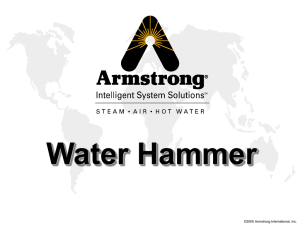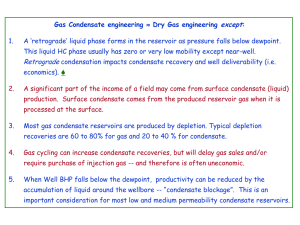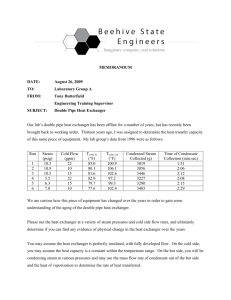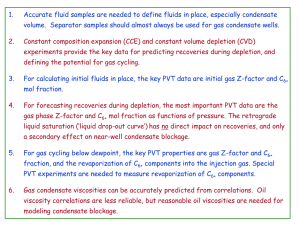Water Hammer Seminar Quiz
advertisement
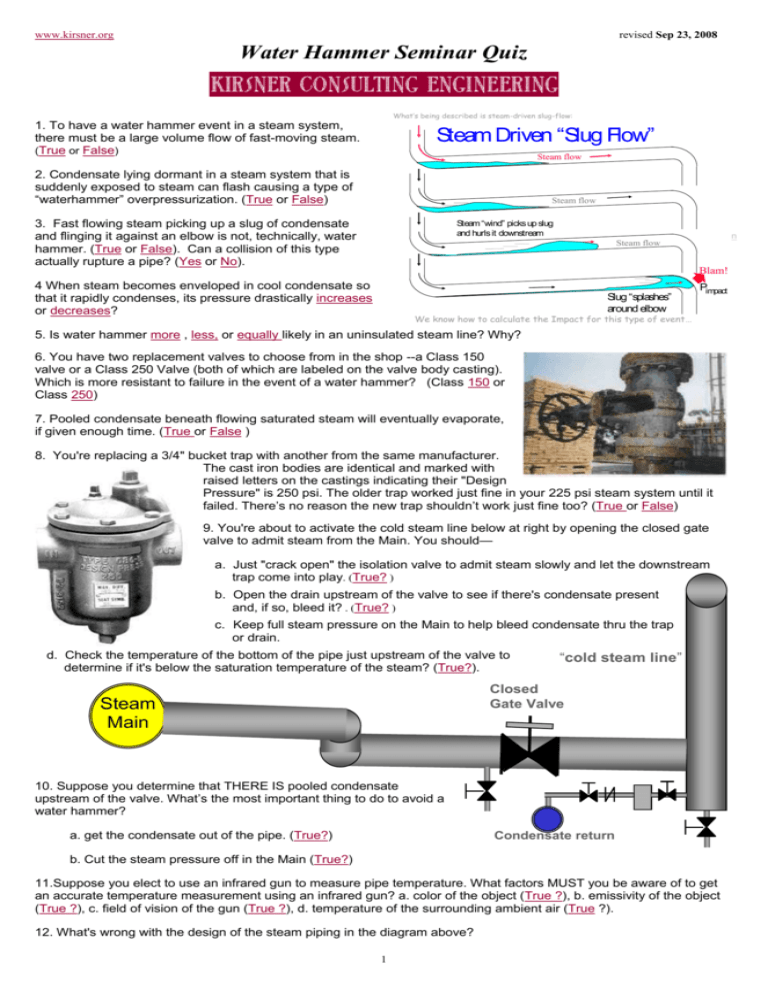
www.kirsner.org revised Sep 23, 2008 Water Hammer Seminar Quiz What’s being described is steam-driven slug-flow: 1. To have a water hammer event in a steam system, there must be a large volume flow of fast-moving steam. (True or False) Steam Driven “Slug Flow” Steam flow 2. Condensate lying dormant in a steam system that is suddenly exposed to steam can flash causing a type of “waterhammer” overpressurization. (True or False) Steam flow Steam “wind” picks up slug and hurls it downstream 3. Fast flowing steam picking up a slug of condensate and flinging it against an elbow is not, technically, water hammer. (True or False). Can a collision of this type actually rupture a pipe? (Yes or No). Slide 7: Waterhammer Definition Steam flow Blam! 4 When steam becomes enveloped in cool condensate so that it rapidly condenses, its pressure drastically increases or decreases? Slug “splashes” Slide21 “Rail Car” around elbow Pimpact Slide 71 of “Steam table” We know how to calculate the Impact for this type event… 5. Is water hammer more , less, or equally likely in an uninsulated steam line? Why? 6. You have two replacement valves to choose from in the shop --a Class 150 valve or a Class 250 Valve (both of which are labeled on the valve body casting). Which is more resistant to failure in the event of a water hammer? (Class 150 or Class 250) 7. Pooled condensate beneath flowing saturated steam will eventually evaporate, if given enough time. (True or False ) 8. You're replacing a 3/4" bucket trap with another from the same manufacturer. The cast iron bodies are identical and marked with raised letters on the castings indicating their "Design Pressure" is 250 psi. The older trap worked just fine in your 225 psi steam system until it failed. There’s no reason the new trap shouldn’t work just fine too? (True or False) 9. You're about to activate the cold steam line below at right by opening the closed gate valve to admit steam from the Main. You should— a. Just "crack open" the isolation valve to admit steam slowly and let the downstream trap come into play. (True? ) b. Open the drain upstream of the valve to see if there's condensate present and, if so, bleed it? . (True? ) c. Keep full steam pressure on the Main to help bleed condensate thru the trap or drain. d. Check the temperature of the bottom of the pipe just upstream of the valve to determine if it's below the saturation temperature of the steam? (True?). “cold steam line” Closed Gate Valve Steam Main 10. Suppose you determine that THERE IS pooled condensate upstream of the valve. What’s the most important thing to do to avoid a water hammer? a. get the condensate out of the pipe. (True?) Condensate return b. Cut the steam pressure off in the Main (True?) 11.Suppose you elect to use an infrared gun to measure pipe temperature. What factors MUST you be aware of to get an accurate temperature measurement using an infrared gun? a. color of the object (True ?), b. emissivity of the object (True ?), c. field of vision of the gun (True ?), d. temperature of the surrounding ambient air (True ?). 12. What's wrong with the design of the steam piping in the diagram above? 1 www.kirsner.org revised Sep 23, 2008 13. When a section of steam line is isolated and allowed to cool to room temperature, the most important reason to open a drain valve and leave it open is-Steam Main To end of line Closed Gate Valve a. to let air fill and passivate the pipe. b. to drain condensate formed from residual steam left inside the line. 15 psi c. to prevent a vacuum from forming in the line d. so drains will be open upon start-up. 15 psi pumped 14. During warm-up/start-up of a 350' long 10" cold steam main from 62oF to the Condensate return saturated steam temperature of 142 psig steam (362oF), about 450 #'s of condensate will form in less than 5 minutes in the steam line. If air is vented but no drain is opened and only a trap at the low point in the line is to be relied upon to drain the condensate to the condensate return system, roughly what percentage of the warm-up condensate load will accumulate in the line before the trap begins to Closed discharge any condensate? a) 0%, b) 10%, c) 25%, d) 50%. e) more than 50%, D 15. The steam trap at right has failed closed. Noting the position of the valves, how high can the level of condensate be expected to build over time in the vertical rise? A., B., C., or D.? open What’s the most likely reason for the trap failure?, 16. If the steam in the Main were superheated, would any condensate at all build-up in the lines even if the trap failed? No, Yes. 120 psi C B Steam Main A 17. Checking for a condensate back-up at a drip leg, you discharge what you expect to be slightly subcooled 100 psi condensate thru a drain. If you’re right, what do you see exiting the drain: a, b, c, or d.? a. a vapor-cloud jetting out the drain more voluminous than if live steam were blowing out. b. condensate flowing out the drain with a small portion turning to vapor that wafts up from the condensate. c. About ½ condensate and ½ steam d. Blowing steam with a small dribble of condensate, but not as much steam as if the drain were blowing live steam with no condensate. 18. The water surrounding a steam main in a flooded manhole is boiling. What's likely going on inside the steam main? (Pipe is expanding due to rapid boiling, or Steam is leaking from pipe, or Pipe is beginning to corrode, or Condensate is filling pipe). Is this dangerous? Why? 19. This question deals with Column-Closure Waterhammer. 10.7 psia Pumped condensate from a receiver rises on its way to the Plant Condensate Receiver. When condensate in the receiver is cool during low steam loads, there’s no problem. But at high steaming loads, condensate tank temperature exceeds 200oF (Vapor Pressure = 11.4 psia). During this condition, whenever the condensate pump starts, there’s a big “bang” which violently shakes the pipe riser and downcomer. Vent to Atmosphere 10 ft ≈ 4 psi the What’s happening when the pump cycles off? Would adding a "soft start" variable speed drive to the pump motor hurt or help? 14.7 Press Would a vacuum breaker added at the top of the system help? Plant Condensate receiver Vent to Atmosphere The key to understanding Column-Closure waterhammer is understanding "Vapor Pressure". Specifically, that if the pressure on condensate falls below the "vapor pressure" of the condensate, the water column will separate. Condensate receiver 200oF condensate 2

